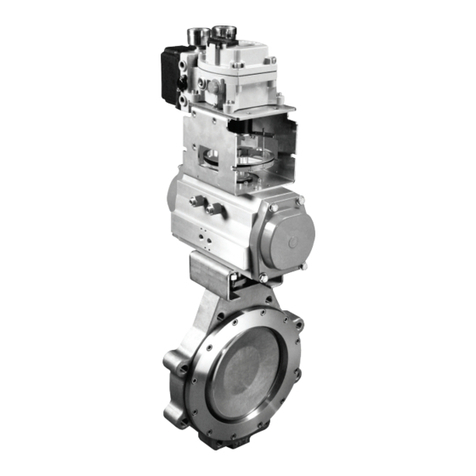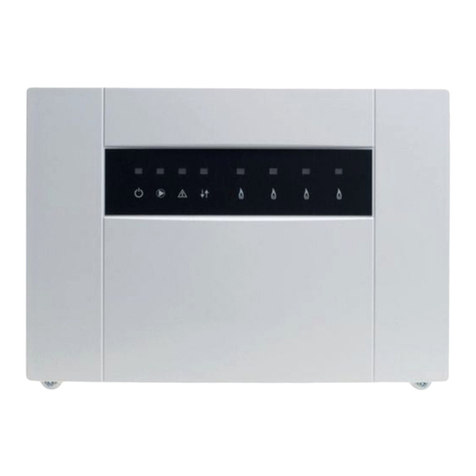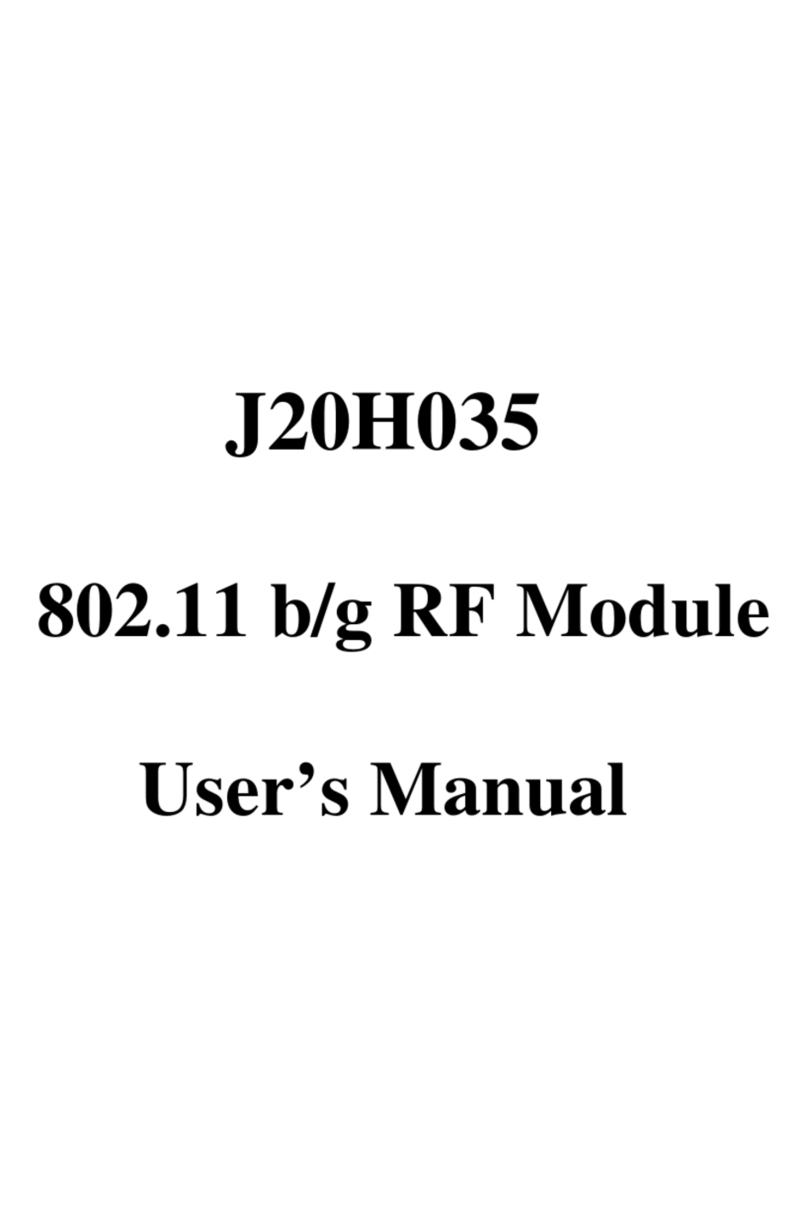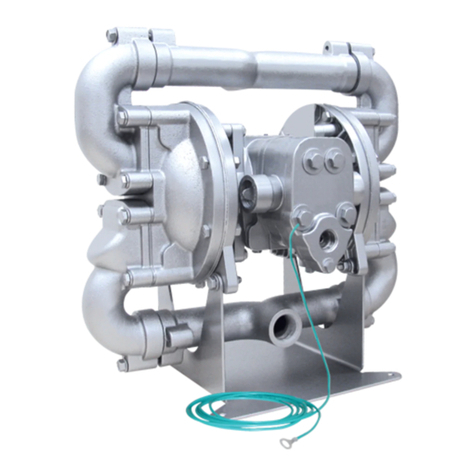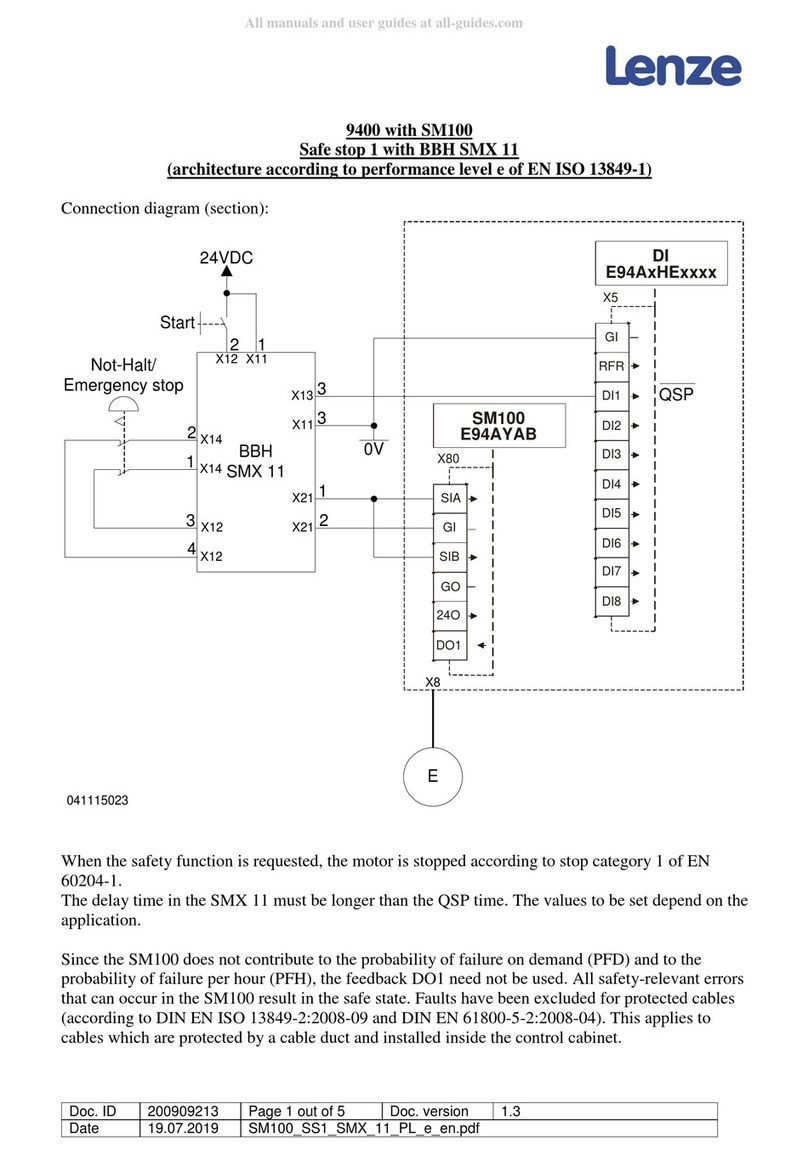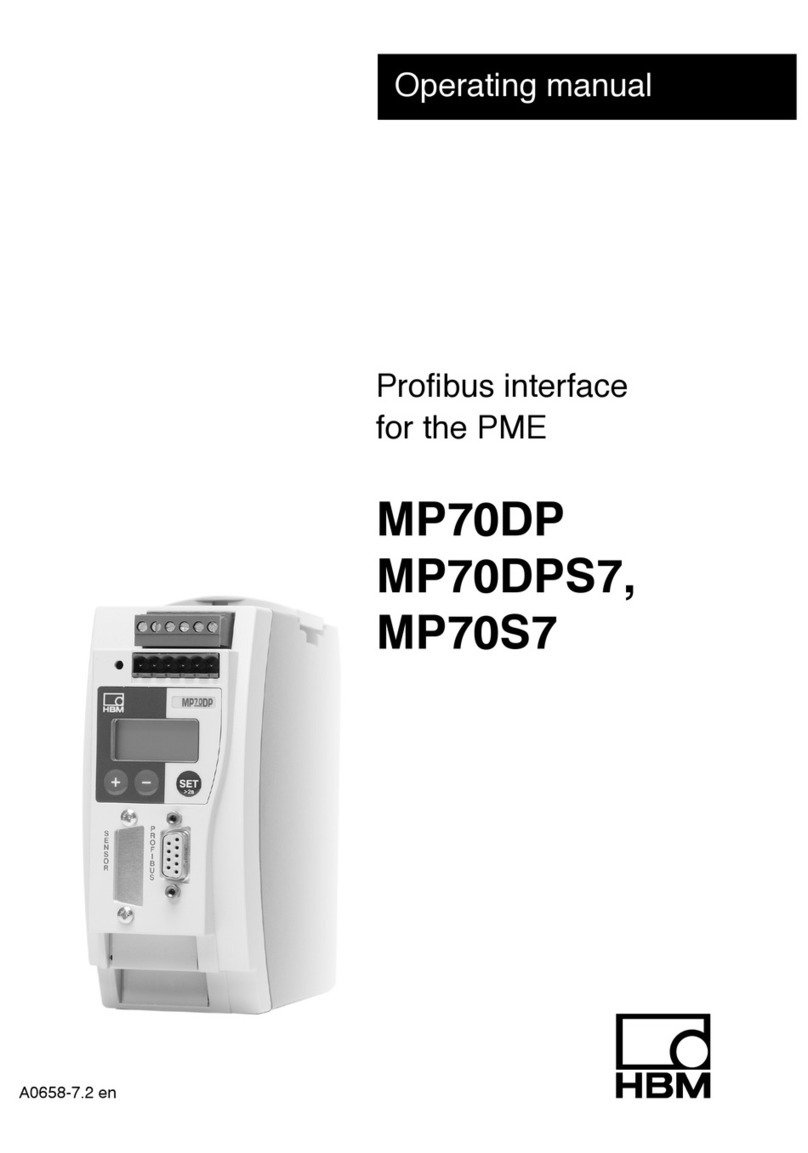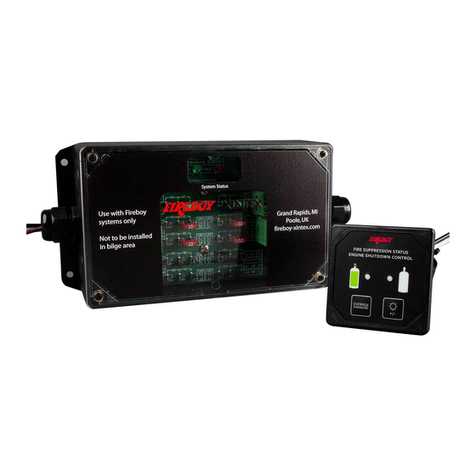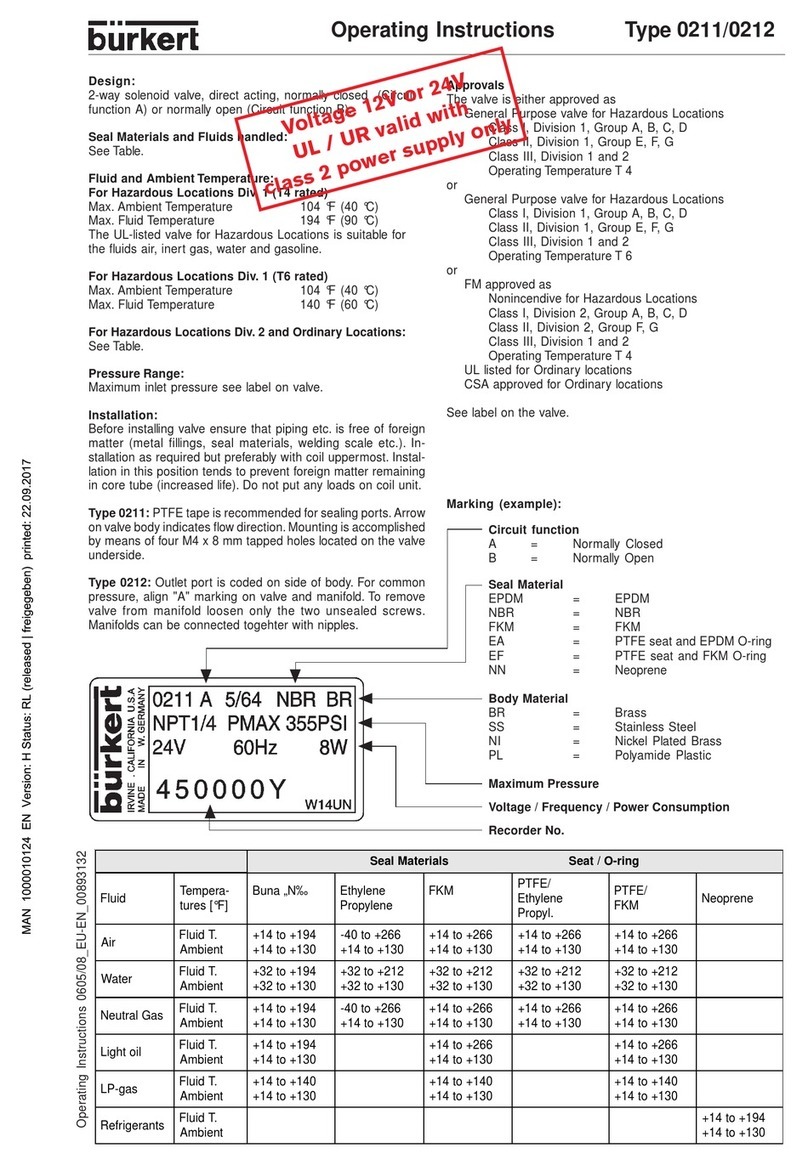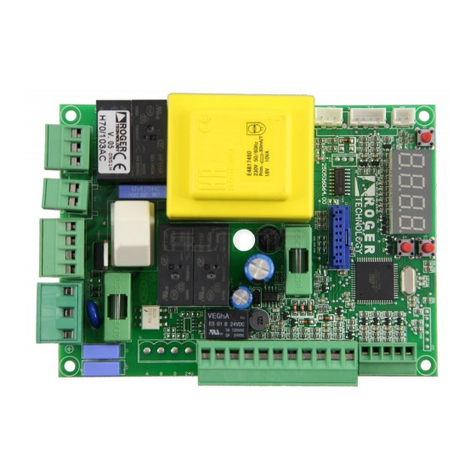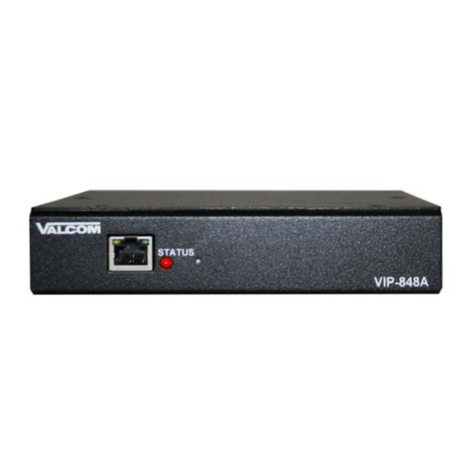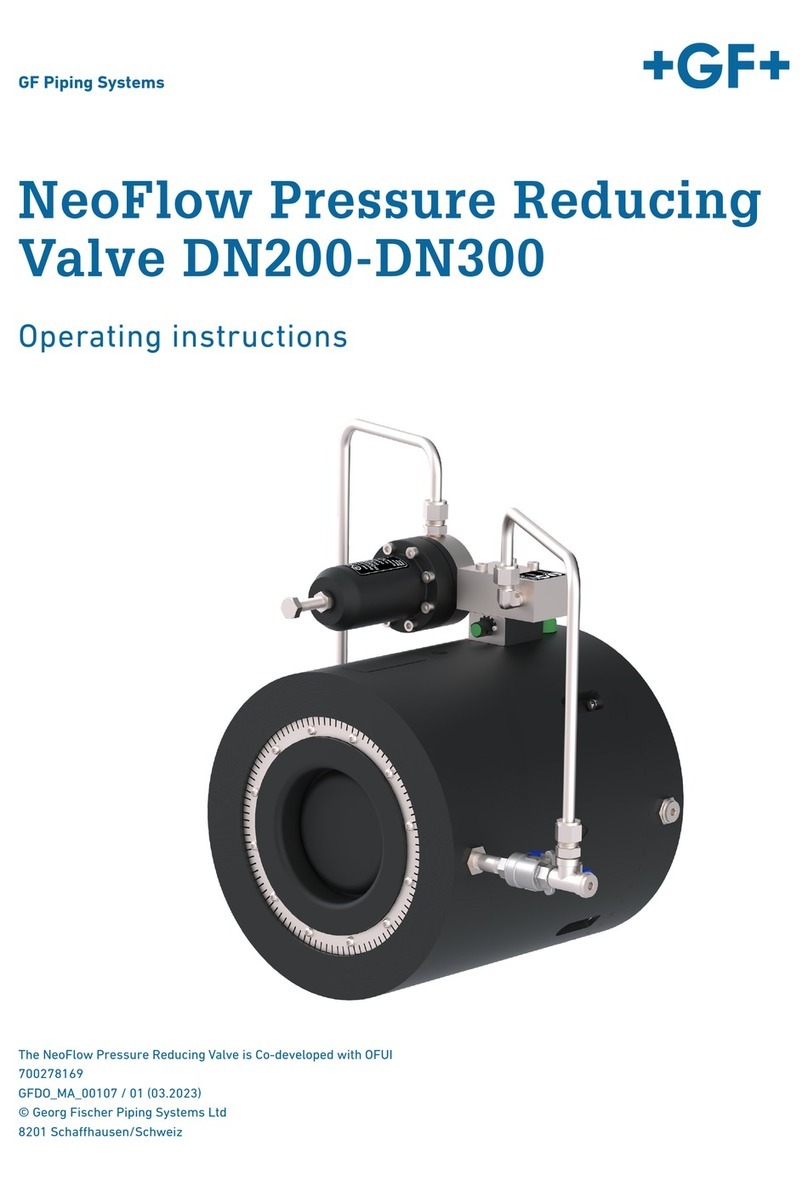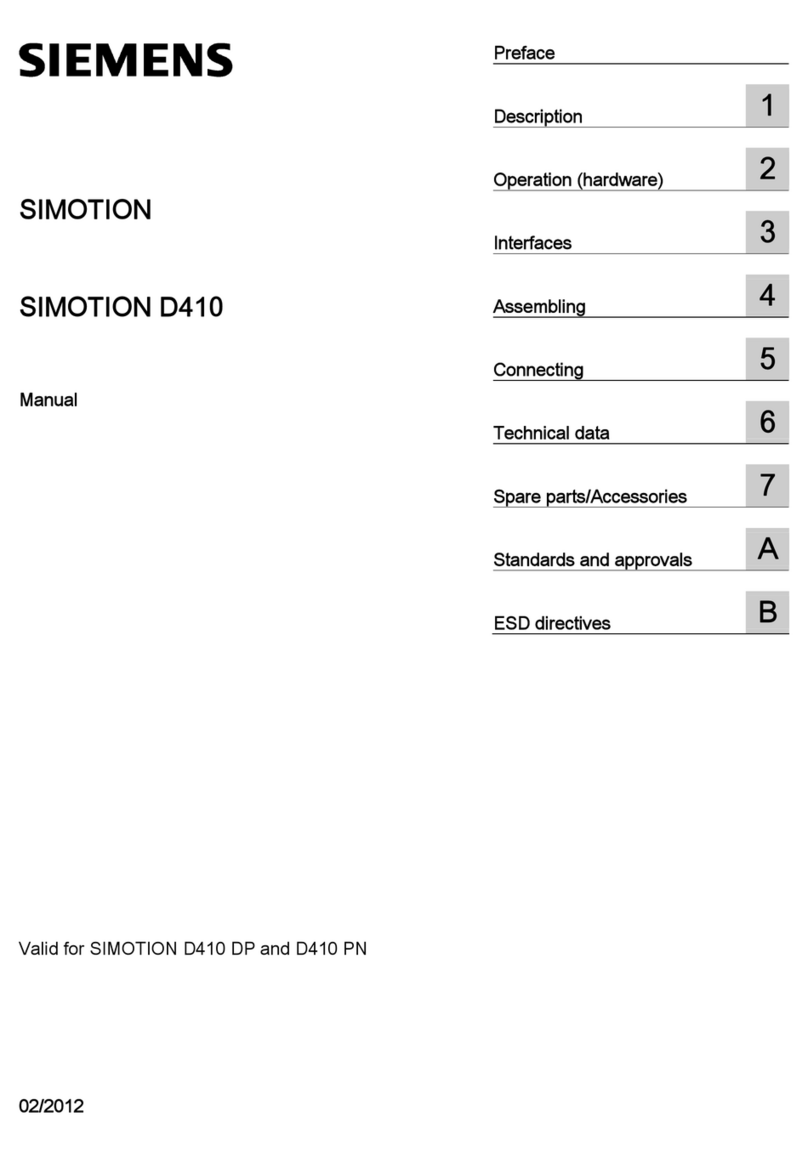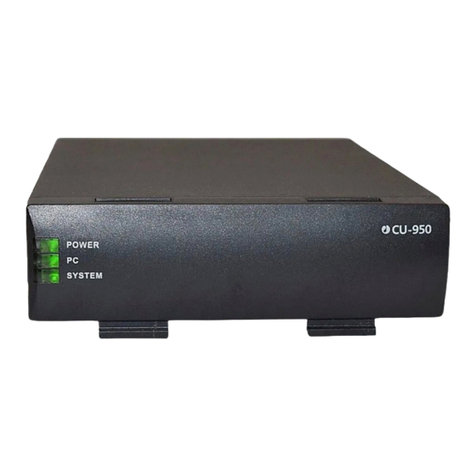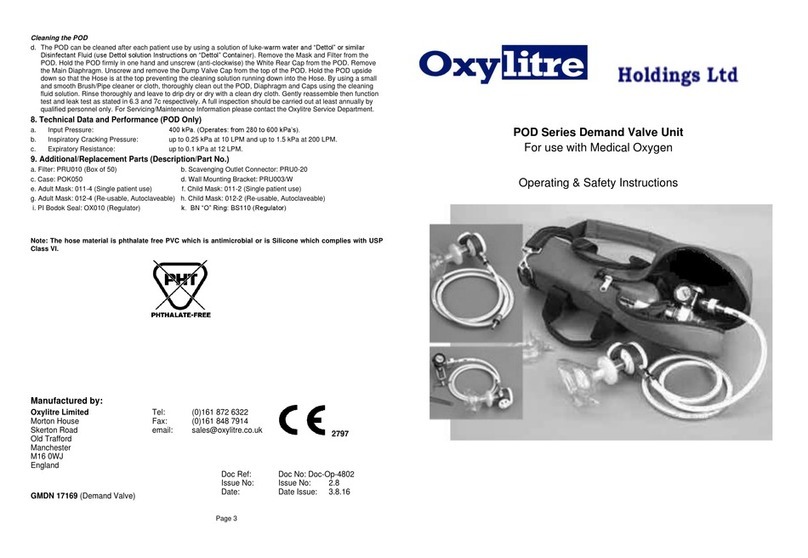Deep Sea Electronics Plc DSE5520 User manual

COMPLEX SOLUTIONS
MADE SIMPLE.
DEEP SEA ELECTRONICS PLC
DSE5520
AUTOMATIC MAINS FAILURE
CONTROL MODULE
OPERATING MANUAL
http://bestgenerator.spb.ru/?page_id=6765

DSE Model 5520 Automatic Mains Failure Control and Instrumentation System Operators Manual
057-016 5520 OPERATING MANUAL ISSUE 6.1 18/06/07 AM
2
Deep Sea Electronics Plc
Highfield House
Hunmanby
North Yorkshire
YO14 0PH
ENGLAND
Sales Tel: +44 (0) 1723 890099
Sales Fax: +44 (0) 1723 893303
E-mail: [email protected]
Website: www.deepseaplc.com
DSE Model 5520 Control and Instrumentation System Operators Manual
© Deep Sea Electronics Plc
All rights reserved. No part of this publication may be reproduced in any material form (including photocopying
or storing in any medium by electronic means or other) without the written permission of the copyright holder
except in accordance with the provisions of the Copyright, Designs and Patents Act 1988.
Applications for the copyright holder’s written permission to reproduce any part of this publication should be
addressed to Deep Sea Electronics Plc at the address above.
Any reference to trademarked product names used within this publication is owned by their respective
companies.
Deep Sea Electronics Plc reserves the right to change the contents of this document without prior notice.
1 BIBLIOGRAPHY
1. IEEE Std C37.2-1996 IEEE Standard Electrical Power System Device Function Numbers and Contact
Designations. Institute of Electrical and Electronics Engineers Inc. ISBN 1-55937-879-4
2. Diesel generator handbook. L.L.J.Mahon. ISBN 0-7506-1147-2
3. On-Site Power Generation. EGSA Education Committee. ISBN 0-9625949-3-8
http://bestgenerator.spb.ru/?page_id=6765

DSE Model 5520 Automatic Mains Failure Control and Instrumentation System Operators Manual
057-016 5520 OPERATING MANUAL ISSUE 6.1 18/06/07 AM 3
TABLE OF CONTENTS
Section Page
1BIBLIOGRAPHY..............................................................................................2
2INTRODUCTION..............................................................................................6
2.1 CLARIFICATION OF NOTATION USED WITHIN THIS PUBLICATION. ..........................7
2.2 ICON DESCRIPTIONS.........................................................................................................7
3OPERATION....................................................................................................8
3.1 CONTROL............................................................................................................................8
3.2 AUTOMATIC OPERATION .................................................................................................9
3.2.1 MAINS FAILURE...........................................................................................................9
3.2.2 REMOTE START IN ISLAND MODE..........................................................................11
3.2.3 REMOTE START ON LOAD.......................................................................................13
3.3 MANUAL OPERATION......................................................................................................15
3.4 TEST OPERATION............................................................................................................17
4PROTECTIONS..............................................................................................19
4.1 WARNINGS........................................................................................................................19
4.2 ANALOGUE PRE-ALARMS..............................................................................................23
4.3 SHUTDOWNS....................................................................................................................26
4.4 ELECTRICAL TRIPS.........................................................................................................30
4.5 ROCOF / VECTOR SHIFT.................................................................................................32
DESCRIPTION OF CONTROLS..........................................................................33
4.6 TYPICAL LCD DISPLAY SCREENS.................................................................................33
4.6.1 TYPICAL STATUS DISPLAY......................................................................................33
4.6.2 TYPICAL INSTRUMENT DISPLAY ............................................................................34
4.6.3 TYPICAL ALARM DISPLAY........................................................................................34
4.6.4 TYPICAL EVENT DISPLAY........................................................................................35
4.6.5 VIEWING THE INSTRUMENT AND EVENT LOG PAGES........................................36
4.6.6 SYNCHROSCOPE OPERATION ...............................................................................37
4.7 COMPLETE INSTRUMENTATION LIST...........................................................................38
4.7.1 BASIC INSTRUMENTATION......................................................................................38
4.7.2 ENHANCED ENGINE INSTRUMENTATION .............................................................38
4.8 ACCESSING THE FRONT PANEL CONFIGURATION EDITOR.....................................39
4.8.1 ENTERING THE CONFIGURATION EDITOR PIN NUMBER....................................39
4.8.2 EDITING VALUES.......................................................................................................40
4.8.3 LIST OF ADJUSTABLE PARAMETERS (MAIN CONFIGURATION EDITOR).........41
4.8.4 LIST OF ADJUSTABLE PARAMETERS (APPLICATION EDITOR) ..........................42
4.9 DISPLAY EDITOR .............................................................................................................43
4.9.1 EDITING ‘DISPLAY EDITOR’ CONFIGURATION VALUES ......................................43
5LED IDENTIFICATION AND FRONT PANEL LAYOUT................................45
5.1 CONFIGURABLE LED IDENTIFICATION DIAGRAM......................................................45
6LED INDICATORS AND LOGO INSERT.......................................................46
7CONTROL PUSH-BUTTONS ........................................................................47
8INSTALLATION INSTRUCTIONS..................................................................50
8.1 PANEL CUT-OUT..............................................................................................................50
8.2 COOLING...........................................................................................................................50
8.3 UNIT DIMENSIONS ...........................................................................................................50
9ELECTRICAL CONNECTIONS......................................................................51
9.1 CONNECTION DETAILS...................................................................................................51
9.1.1 PLUG “A” 8 WAY.........................................................................................................51
9.1.2 PLUG “B” 11 WAY.......................................................................................................51
9.1.3 PLUG “C” 9 WAY ........................................................................................................52
9.1.4 PLUG “D” 3 WAY ........................................................................................................52
http://bestgenerator.spb.ru/?page_id=6765

DSE Model 5520 Automatic Mains Failure Control and Instrumentation System Operators Manual
057-016 5520 OPERATING MANUAL ISSUE 6.1 18/06/07 AM
4
9.1.5 PLUG “E” 5 WAY........................................................................................................52
9.1.6 PLUG “F” 8 WAY ........................................................................................................53
9.1.7 PLUG “G” 4 WAY........................................................................................................53
9.1.8 PLUG “H” 12 WAY......................................................................................................53
9.1.9 PC CONFIGURATION INTERFACE CONNECTOR..................................................54
9.1.10 EXPANSION INTERFACE CONNECTOR.................................................................54
9.2 CONNECTOR FUNCTION DETAILS................................................................................55
9.2.1 PLUG “A” 8 WAY........................................................................................................55
9.2.2 PLUG “B” 11 WAY......................................................................................................55
9.2.3 PLUG “C” 9 WAY........................................................................................................56
9.2.4 PLUG “D” 3 WAY........................................................................................................56
9.2.5 PLUG “E” 5 WAY........................................................................................................57
9.2.6 PLUG “F” 8 WAY ........................................................................................................57
9.2.7 PLUG “G” 4 WAY........................................................................................................57
9.2.8 PLUG “H” 12 WAY......................................................................................................58
9.3 ENGINE CONTROL UNIT INTERFACE...........................................................................59
10 SPECIFICATION .........................................................................................60
11 COMMISSIONING .......................................................................................62
11.1.1 PRE-COMMISSIONING.............................................................................................62
11.2 BYPASSING ALARMS AT STARTUP..........................................................................63
11.3 COMMISSIONING SCREENS.......................................................................................63
11.3.1 SCREEN 1..................................................................................................................63
11.3.2 SCREEN 2..................................................................................................................63
11.3.3 SCREEN 3..................................................................................................................63
11.3.4 SCREEN 4..................................................................................................................63
12 FAULT FINDING..........................................................................................64
13 TYPICAL WIRING DIAGRAM .....................................................................65
14 FACTORY DEFAULT CONFIGURATION...................................................66
15 SENDER WIRING RECOMMENDATIONS..................................................70
15.1.1 USING EARTH RETURN (SINGLE WIRE) SENDERS. ............................................70
15.1.2 USING INSULATED RETURN (TWO WIRE) SENDERS..........................................71
16 APPENDIX...................................................................................................72
16.1 5520 IDMT TRIPPING CURVES (TYPICAL).................................................................72
16.2 5510 SHORT CIRCUIT TRIPPING CURVES (TYPICAL).............................................72
16.3 ACCESSORIES .............................................................................................................73
16.3.1 OUTPUT EXPANSION...............................................................................................73
RELAY OUTPUT EXPANSION (157)....................................................................................73
LED OUTPUT EXPANSION (548) ........................................................................................73
16.3.2 INPUT EXPANSION (P130/P540/P541)....................................................................73
16.4 COMMUNICATIONS OPTION.......................................................................................74
16.4.1 DESCRIPTION ...........................................................................................................74
16.4.2 PC TO CONTROLLER (DIRECT) CONNECTION.....................................................74
16.4.3 MODEM TO CONTROLLER CONNECTION.............................................................74
16.4.4 RS485 LINK TO CONTROLLER................................................................................75
TYPICAL BUILDING MANAGEMENT SCHEME USING RS485 MONITORING.................76
16.4.5 MODBUS™.................................................................................................................76
16.5 IEEE C37.2 STANDARD ELECTRICAL POWER SYSTEM DEVICE FUNCTION
NUMBERS....................................................................................................................................77
16.6 ENCLOSURE CLASSIFICATIONS...............................................................................79
IP CLASSIFICATIONS ..........................................................................................................79
NEMA CLASSIFICATIONS...................................................................................................80
12. SYNCHRONISING NOTES..........................................................................81
16.6.1 CHECK SYNC ............................................................................................................81
16.6.2 AUTO SYNC...............................................................................................................81
16.6.3 LOAD CONTROL .......................................................................................................81
http://bestgenerator.spb.ru/?page_id=6765

DSE Model 5520 Automatic Mains Failure Control and Instrumentation System Operators Manual
057-016 5520 OPERATING MANUAL ISSUE 6.1 18/06/07 AM 5
MAINS CT..............................................................................................................................81
16.6.4 TYPICAL PEAK LOPPING SYSTEM..........................................................................82
http://bestgenerator.spb.ru/?page_id=6765

DSE Model 5520 Automatic Mains Failure Control and Instrumentation System Operators Manual
057-016 5520 OPERATING MANUAL ISSUE 6.1 18/06/07 AM
6
2 INTRODUCTION
The DSE 5520 Module has been designed to allow the OEM to meet demand for increased
capability within the industry. It has been primarily designed to allow the user to start and stop the
generator and if required, transfer the load to the generator either manually or automatically, or in
the event of the module detecting a mains failure. The user also has facility to view all the system
operating parameters via the LCD display.
Utilising the inbuilt synchronising, volts matching and paralleling functions, the 5520 can also be
used to parallel with the mains supply for no break return, peak lopping or power import / export
functionality and load control.
The DSE 5520 module monitors the incoming AC mains supply for under or over voltage / under or
over frequency and instructs the generating set to start and to supply the load.
The DSE 5520 module also monitors the engine, indicating the operational status and fault
conditions; automatically shutting down the engine and giving a true first-up fault condition of an
engine failure by a flashing COMMON ALARM LED. Exact failure mode information is indicated by
the LCD display on the front panel.
The powerful Micro-processor contained within the module allows for a range of enhanced
features to be incorporated as standard;
•Full Multi-lingual LCD displays (including non-western character fonts).
•True RMS voltage monitoring.
•Power measurement instrumentation.
•Communications capability (RS485 or RS232 including GSM/SMS functions)
•Check Sync capability
•Automatic Sync capability
•Load control capability
•Fully configurable inputs for use as alarms or a range of different functions.
•Extensive range of output functions using built in relay outputs or relay expansion available.
•CAN instrumentation and diagnostics when connected to a compatible CAN (electronically
controlled) engine controller.
Selective operational sequences, timers and alarm trips can be adjusted by the customer via the
integral front panel configuration editor.
Comprehensive configuration is made using the 5xxx For Windows ™ software and 810 interface
module
Access to critical operational sequences and timers for use by qualified engineers, can be barred
by a security code. Module access can also be barred by PIN code. Selected parameters can be
changed from the module’s front panel.
The module is housed in a robust plastic case suitable for panel mounting. Connections to the
module are via locking plug and sockets.

DSE Model 5520 Automatic Mains Failure Control and Instrumentation System Operators Manual
057-016 5520 OPERATING MANUAL ISSUE 6.1 18/06/07 AM 7
2.1 CLARIFICATION OF NOTATION USED WITHIN THIS PUBLICATION.
NOTE:
Highlights an essential element of a procedure to ensure
correctness.
CAUTION!
Indicates a procedure or practice which, if not strictly observed,
could result in damage or destruction of equipment.
WARNING!
Indicates a procedure or practice which could result in injury to
personnel or loss of life if not followed correctly.
©
Deep Sea Electronics Plc owns the copyright to this manual, which
cannot be copied, reproduced or disclosed to a third party without
prior written permission.
2.2 ICON DESCRIPTIONS
Symbol Meaning Description
Stop/Reset Stop the generator and reset any alarm conditions.
I Start Start the generator (if in an appropriate mode).
Auto The controller will automatically start the generator
when given a remote start command.
Manual The controller will start the generator under manual
control. (Separate Start command may be necessary)
Mains Failure Simulation
(Test) On AMF modules, this is used to simulate a mains
failure event. (On-load test)
Alarm Mute Silences the audible warning device.
Information Changes the display to another page
Up Selects the previous item on the page
Down Selects the next item on the page
Close mains Close mains load switching device (manual mode
only)
Close generator Close generator load switching device (manual mode
only)
9Accept Edit or save current selection (configuration mode
only)
+ Increase Increase current selection (configuration mode only)
- Decrease Decrease current selection (configuration mode only)

DSE Model 5520 Automatic Mains Failure Control and Instrumentation System Operators Manual
057-016 5520 OPERATING MANUAL ISSUE 6.1 18/06/07 AM
8
3 OPERATION
3.1 CONTROL
Control of the DSE 5520 module is via push buttons mounted on the front of the module with
STOP/RESET, MANUAL, TEST, AUTO, LAMP TEST and ALARM MUTE and START functions.
For normal operation, these are the only controls which need to be operated. The smaller push
buttons are used to access further information such as engine instruments and load switching
operations. Detail of their operation is covered later in this document.
The following descriptions detail the sequences followed by a module containing the standard
‘factory configuration’. Always refer to your configuration source for the exact sequences and
timers observed by any particular module in the field.
CAUTION: - The module may instruct an engine start event due to external
influences. Therefore, it is possible for the engine to start at any time without warning.
Prior to performing any maintenance on the system, it is recommended that steps are
taken to isolate DC supplies and remove the battery.

DSE Model 5520 Automatic Mains Failure Control and Instrumentation System Operators Manual
057-016 5520 OPERATING MANUAL ISSUE 6.1 18/06/07 AM 9
3.2 AUTOMATIC OPERATION
3.2.1 MAINS FAILURE
This mode of operation is used to ensure continuity of supply to critical loads during a mains failure
condition. This is the normal mode of operation when installed on a standby generator.
NOTE: - If a digital input configured to panel lock is active, changing module modes
will not be possible. Viewing the instruments and iare NOT affected by panel
lock. If panel lock is active the Panel lock indicator (if configured) illuminates.
This mode is activated by pressing the pushbutton. An LED indicator beside the button
will illuminate to confirm this operation.
Should the mains (utility) supply fall outside the configurable limits for longer than the period of the
mains transient delay timer, the mains (utility) available GREEN indicator LED extinguishes.
To allow for short term mains supply transient conditions, the Start Delay timer is initiated. After
this delay, if the pre-heat output option is selected then the pre-heat timer is initiated and the
corresponding auxiliary output (if configured) will energise.
NOTE: - If the mains supply returns within limits during the Start Delay timer, the unit
will return to a stand-by state.
After the above delays have expired the Fuel Solenoid (or enable ECU output if configured) is
energised, then one second later, the Starter Motor is engaged.
NOTE:- If the unit has been configured for CAN Bus, compatible ECU’s will receive
the start command via CAN Bus. Refer to the Manual CAN and DSE Wiring. Part No. 057-
004 for more information on utilising DSE modules with electronically controlled engines.
The engine is cranked for a pre-set time. If the engine fails to fire during this cranking attempt then
the starter motor is disengaged for the pre-set rest period. Should this sequence continue beyond
the set number of attempts, the start sequence will be terminated and Fail to Start fault will be
displayed.
Alarm
Shutdown
Fail to start
When the engine fires, the starter motor is disengaged and locked out at a pre-set frequency
measured from the alternator output. Alternatively, a Magnetic Pickup mounted on the flywheel
housing can be used for speed detection (This is selected by PC using the 5xxx series
configuration software). Rising oil pressure can also be used to disconnect the starter motor;
however it cannot be used for underspeed or overspeed detection.
NOTE:- If the unit has been configured for CAN Bus, speed sensing is via CAN Bus.

DSE Model 5520 Automatic Mains Failure Control and Instrumentation System Operators Manual
057-016 5520 OPERATING MANUAL ISSUE 6.1 18/06/07 AM
10
After the starter motor has disengaged, the Safety On timer is activated, allowing Oil Pressure,
High Engine Temperature, Under-speed, Charge Fail and any delayed Auxiliary fault inputs to
stabilise without triggering the fault.
Once the engine is running, the Warm Up timer, if selected is initiated, allowing the engine to
stabilise before accepting the load.
After the Warm-up timer has expired then the module will transfer the load from the failed mains
supply to the generator output. It will observe the following sequence. The Mains
Contactor/Breaker will be instructed to open and after a short delay (transfer delay), the
Generator Contactor/Breaker will be instructed to close.
The generator will then supply the requirements of the load.
NOTE:-A load transfer will not be initiated until the Oil Pressure has risen. This
prevents excessive wear on the engine.
When the mains supply returns, the Stop delay timer is initiated. Once it has expired, the set is
synchronised and paralleled with the mains supply. The system remains in this condition until
expiry of the Parallel run timer. Once this has expired, the module will ramp the remaining load
from the generator to mains supply. The Generator Contact/Breaker will open and the Cooling
timer is then initiated, allowing the engine a cooling down period off load before shutting down.
Once the Cooling timer expires, the Fuel Solenoid is de-energised, bringing the generator to a
stop.
During the parallel run, the module can be configured to either run at a fixed level output, or to
maintain an output in relation to the load level on the mains. For full details of these mode please
refer to the manual ‘The Guide to sync and load share Pt1’
Should the mains supply fall outside limits once again the set will return on load.
NOTE: - When synchronising is enabled, the mains supply is checked before closing
any load switching device. If the supply is live, synchronising will take place before any
closure takes place.
NOTE: - Synchronising can be disabled if the application does not require this
function. Contact your genset supplier in the first instance for further details.

DSE Model 5520 Automatic Mains Failure Control and Instrumentation System Operators Manual
057-016 5520 OPERATING MANUAL ISSUE 6.1 18/06/07 AM 11
3.2.2 REMOTE START IN ISLAND MODE
This mode of operation is used to start the set in response to an external start requirement from
another device. It may also be used to provide continuity of supply during expected black out
events.
NOTE:- If a digital input configured to panel lock is active, changing module modes
will not be possible. Viewing the instruments and iare NOT affected by panel
lock. If panel lock is active the Panel lock indicator (if configured) illuminates.
This mode is activated by pressing the pushbutton. An LED indicator beside the button
will illuminate to confirm this operation.
If the remote start in island mode input activates, the Remote Start Active indicator (if configured)
illuminates.
To allow for false remote start signals, the Start Delay timer is initiated. After this delay, if the pre-
heat output option is selected then the pre-heat timer is initiated and the corresponding auxiliary
output (if configured) will energise.
NOTE:- If the Remote Start signal is removed during the Start Delay timer, the unit
will return to a stand-by state.
After the above delays, the Fuel Solenoid (or enable ECU output if configured) is energised, and
then one second later, the Starter Motor is engaged.
NOTE: - If the unit has been configured for CAN Bus, compatible ECU’s will receive
the start command via CAN Bus. Refer to the Manual CAN and DSE Wiring. Part No. 057-
004 for more information on utilising DSE modules with electronically controlled engines.
The engine is cranked for a pre-set time. If the engine fails to fire during this cranking attempt then
the starter motor is disengaged for the pre-set rest period. Should this sequence continue beyond
the set number of attempts, the start sequence will be terminated and Fail to Start fault will be
displayed.
Alarm
Shutdown
Fail to start
When the engine fires, the starter motor is disengaged and locked out at a pre-set frequency
measured from the alternator output. Alternatively, a Magnetic Pickup mounted on the flywheel
housing can be used for speed detection (This is selected by PC using the 5xxx series
configuration software). Rising oil pressure can also be used to disconnect the starter motor;
however, it cannot be used for underspeed or overspeed detection.
NOTE: - If the unit is configured for CAN Bus, speed sensing is via CAN Bus.

DSE Model 5520 Automatic Mains Failure Control and Instrumentation System Operators Manual
057-016 5520 OPERATING MANUAL ISSUE 6.1 18/06/07 AM
12
After the starter motor has disengaged, the Safety On timer is activated, allowing Oil Pressure,
High Engine Temperature, Under-speed, Charge Fail and any delayed Auxiliary fault inputs to
stabilise without triggering the fault.
Once the engine is running, the Warm Up timer, if selected is initiated, allowing the engine to
stabilise before accepting the load.
NOTE: - A load transfer will not be initiated until the Oil Pressure has risen. This
prevents excessive wear on the engine.
The Generator will first be instructed to synchronise with the mains supply before closing the
Generator Contact/Breaker and transferring load from mains to generator until the generator is
supplying the required amount of power (adjustable using 5xxx configuration software).
When the supplies have been in parallel for the duration of the parallel run time, the load will
ramp off the mains supply and onto the generator. The Mains Contactor/Breaker will be
instructed to open.
The generator will then supply the requirements of the load.
When the remote start signal is removed, the Stop delay timer is initiated. Once it has expired, the
set is synchronised and paralleled with the mains supply.
The system remains in this condition until expiry of the Parallel run timer. Once this has expired,
the module will ramp the remaining load from the generator to mains supply.
The Generator Contact/Breaker will open and the Cooling timer is then initiated, allowing the
engine a cooling down period off load before shutting down.
Once the Cooling timer expires, the Fuel Solenoid is de-energised, bringing the generator to a
stop.
NOTE: - Synchronising can be disabled if the application does not require this
function. Contact your generating set supplier in the first instance for further details.
NOTE: - The internal ‘Scheduler’ can be configured to operate they system in the
same manner as described for the Remote start input. Please refer to the 5xxx
Configuration Software manuals for full details on the feature.

DSE Model 5520 Automatic Mains Failure Control and Instrumentation System Operators Manual
057-016 5520 OPERATING MANUAL ISSUE 6.1 18/06/07 AM 13
3.2.3 REMOTE START ON LOAD
This mode of operation is used to start the set in response to rising load levels on the mains supply
(if configured).
NOTE: - If a digital input configured to panel lock is active, changing module modes
will not be possible. Viewing the instruments and iare NOT affected by panel
lock. If panel lock is active the Panel lock indicator (if configured) illuminates.
This mode is activated by pressing the pushbutton. An LED indicator beside the button
will illuminate to confirm this operation.
Should the load level on the mains supply exceed a pre-set level the module will initiate a start
sequence.
To allow for short duration load surges, the Start Delay timer is initiated. After this delay, if the pre-
heat output option is selected then the pre-heat timer is initiated and the corresponding auxiliary
output (if configured) will energise.
NOTE: - If the load level returns below the pre-set level during the Start Delay timer,
the unit will return to a stand-by state.
After the above delays, the Fuel Solenoid (or enable ECU output if configured) is energised, and
then one second later, the Starter Motor is engaged.
NOTE: - If the unit has been configured for CAN Bus, compatible ECU’s will receive
the start command via CAN Bus. Refer to the Manual CAN and DSE Wiring. Part No. 057-
004 for more information on utilising DSE modules with electronically controlled engines.
The engine is cranked for a pre-set time. If the engine fails to fire during this cranking attempt then
the starter motor is disengaged for the pre-set rest period. Should this sequence continue beyond
the set number of attempts, the start sequence will be terminated and Fail to Start fault will be
displayed.
Alarm
Shutdown
Fail to start
When the engine fires, the starter motor is disengaged and locked out at a pre-set frequency
measured from the alternator output. Alternatively, a Magnetic Pickup mounted on the flywheel
housing can be used for speed detection (This is selected by PC using the 5xxx series
configuration software). Rising oil pressure can also be used to disconnect the starter motor;
however, it cannot be used for underspeed or overspeed detection.
NOTE: - If the unit is configured for CAN Bus, speed sensing is via CAN Bus.

DSE Model 5520 Automatic Mains Failure Control and Instrumentation System Operators Manual
057-016 5520 OPERATING MANUAL ISSUE 6.1 18/06/07 AM
14
After the starter motor has disengaged, the Safety On timer is activated, allowing Oil Pressure,
High Engine Temperature, Under-speed, Charge Fail and any delayed Auxiliary fault inputs to
stabilise without triggering the fault.
Once the engine is running, the Warm Up timer, if selected is initiated, allowing the engine to
stabilise before accepting the load.
After the Warm-up timer has expired then the module will transfer the load from the mains supply
to the generator output. It will observe the following sequence.
The Generator will first be instructed to synchronise with the mains supply. Once these are
matched, the Generator Contact/Breaker will be instructed to close.
The load will then be ramped from the Mains to the appropriate level on the generator.
The generator will then supply the requirements of the load.
NOTE: - A load transfer will not be initiated until the Oil Pressure has risen. This
prevents excessive wear on the engine.
When the remote start on load input is removed, the Stop delay timer is initiated. Once this timer
has expired, the module will ramp the load from the generator to mains supply. The Generator
Contact/Breaker will open and the Cooling timer is then initiated, allowing the engine a cooling
down period off load before shutting down. Once the Cooling timer expires, the Fuel Solenoid is
de-energised, bringing the generator to a stop.
During the parallel run, the module can be configured to either run at a fixed level output, or to
maintain an output in relation to the load level on the mains.
NOTE: - When synchronising is enabled, the mains supply is checked before closing
any load switching device. If the supply is live, synchronising will take place before any
closure takes place.
NOTE: - Synchronising can be disabled if the application does not require this
function. Contact your genset supplier in the first instance for further details.
NOTE: - The load level mode of operation relies on a Current Transformer (CT) fitted
to the mains feed of the system. This is then used for measurement of the mains current
used in the load level calculations.

DSE Model 5520 Automatic Mains Failure Control and Instrumentation System Operators Manual
057-016 5520 OPERATING MANUAL ISSUE 6.1 18/06/07 AM 15
3.3 MANUAL OPERATION
Manual mode is used to allow the operator to control the operation of the generator, and to provide
fault finding and diagnostic testing of the various operations normally performed during Automatic
mode operation.
NOTE: - If a digital input configured to panel lock is active, changing module modes
will not be possible. Viewing the instruments and event logs iis NOT affected by
panel lock. If panel lock is active the Panel lock indicator (if configured) illuminates.
MANUAL, mode is selected by pressing the pushbutton. An LED besides the button will
illuminate to confirm this operation. When the START (I) button is operated, the module will initiate
the start sequence.
NOTE: - There is no Start Delay in this mode of operation.
If the pre-heat output option has been selected, this timer will be initiated and the auxiliary output
selected energised.
After the above delay, the Fuel Solenoid (or ECU output if configured) is energised, and then one
second later, the Starter Motor is engaged.
NOTE:- If the unit is configured for CAN Bus, compatible ECU’s will receive the start
command via CAN Bus. Refer to the Manual CAN and DSE Wiring. Part No. 057-004 for
more information on utilising DSE modules with electronically controlled engines.
The engine is cranked for a pre-set time. If the engine fails to fire during this cranking attempt then
the starter motor is disengaged for the pre-set rest period. Should this sequence continue beyond
the set number of attempts, the start sequence will be terminated and Fail to Start will be
displayed.
Alarm
Shutdown
Fail to start
When the engine fires, the starter motor is disengaged and locked out at a pre-set frequency
measured from the Alternator output. Alternatively, a Magnetic Pickup mounted on the flywheel
housing can be used for speed detection (This is selected by PC using the 5xxx series
configuration software). Rising oil pressure can also be used to disconnect the starter motor;
however, it cannot be used for underspeed or overspeed detection.
NOTE: - If the unit is configured for CAN Bus, speed sensing is via CAN Bus.
After the starter motor has disengaged, the Safety On timer is activated, allowing Oil Pressure,
High Engine Temperature, Under-speed, Charge Fail and any delayed Auxiliary fault inputs to
stabilise without triggering the fault.
Once the engine is running, the Warm Up timer (if selected) is initiated, allowing the engine to
stabilise before it can be loaded. Once the warm up timer has expired, the generator is then
available to go on load and the Generator Available LED will illuminate on the front panel.
The generator will run off load unless:

DSE Model 5520 Automatic Mains Failure Control and Instrumentation System Operators Manual
057-016 5520 OPERATING MANUAL ISSUE 6.1 18/06/07 AM
16
1. The mains supply fails,
2. A Remote Start on load signal is applied, or an on-load run is configured in the scheduler.
3. The Close Generator button is pressed.
If any of the above signals are received, the generator is synchronised and paralleled with the
mains supply (if available).
During the parallel run, the module can be configured to either run at a fixed level output, or to
maintain an output in relation to the load level on the mains. For full details of these mode please
refer to the manual ‘The Guide to sync and load share Pt1’
Parallel operation:
•If the Close Generator button is pressed again while in parallel, then the module will
transfer the load fully to the generators, removing the load from the mains supply. This will be
achieved by ramping the load from the parallel operating level to the generator. The Mains
Contactor/Breaker will then be opened. Pressing the Close Mains button will cause the
module to re-synchronise the generator with the mains supply and then return to parallel
operation.
•If the Close Mains button is pressed while in parallel, the module will open the generator
load switching device, transferring the load fully to the mains supply.
If Auto mode is selected and the mains supply is healthy, and the remote start on load signal not
active, and the scheduler is not calling for a run, then the Return Delay Timer will start.
Once this has expired then the module will exit parallel operation and will ramp the load back to
the mains supply. It will then open the Generator Contactor/Breaker. The generator will then run
off load allowing the engine a cooling period.
Selecting STOP (O) de-energises the FUEL SOLENOID, bringing the generator to a stop.
WARNING: - Operation of the STOP button in any mode will stop the generator
operation and return the load switching system to a safe state. This operation may lead
to loss of supply to the load. It is recommended that the STOP button is only operated
once the generator is OFF LOAD and the mains is supplying the load.
NOTE: - Synchronising can be disabled if the application does not require this
function. Contact your genset supplier in the first instance for further details. If
synchronising is disabled the system will always perform an open transition when
switching the load from the mains to the generator or when returning to the mains. The
parallel run stages of the sequence are not used when operating in this way.
NOTE: - When synchronising is enabled, the mains supply is checked before closing
any load switching device. If the supply is live, synchronising will take place before any
closure takes place.

DSE Model 5520 Automatic Mains Failure Control and Instrumentation System Operators Manual
057-016 5520 OPERATING MANUAL ISSUE 6.1 18/06/07 AM 17
3.4 TEST OPERATION
Test operation is used to perform a full on load test sequence to allow for diagnosis of faults.
Alternatively, it may also be used to provide continuity of supply during expected black out events,
peak lopping or peak shaving during high tariff periods.
NOTE: - If a digital input configured to panel lock is active, changing module modes
will not be possible. Viewing the instruments and event logs iis NOT affected by
panel lock. If panel lock is active the Panel lock indicator (if configured) illuminates.
TEST mode is initiated by pressing the pushbutton. An LED besides the button will illuminate
to confirm this operation. When the START (I) button is operated, the module will initiate the start
sequence.
NOTE: - There is no Start Delay in this mode of operation.
If the pre-heat output option has been selected, this timer will initiate and the auxiliary output
selected will be energised.
After the above delay, the Fuel Solenoid (or ECU output if configured) is energised, and then one
second later, the Starter Motor is engaged.
NOTE: - If the unit has been configured for CAN Bus, compatible ECU’s will receive
the start command via CAN Bus. Refer to the Manual CAN and DSE Wiring. Part No. 057-
004 for more information on utilising DSE modules with electronically controlled engines.
The engine is cranked for a pre-set time. If the engine fails to fire during this cranking attempt then
the starter motor is disengaged for the pre-set rest period. Should this sequence continue beyond
the set number of attempts, the start sequence will be terminated and Fail to Start will be
displayed.
Alarm
Shutdown
Fail to start
When the engine fires, the starter motor is disengaged and locked out at a pre-set frequency from
the Alternator output. Alternatively, a Magnetic Pickup mounted on the flywheel housing can be
used for speed detection (This is selected by PC using the 5xxx series configuration software).
Rising oil pressure can also be used to disconnect the starter motor; however, it cannot be used
for underspeed or overspeed detection.
NOTE: - If the unit has been configured for CAN Bus speed sensing is via CAN Bus.
After the starter motor has disengaged, the Safety On timer is activated, allowing Oil Pressure,
High Engine Temperature, Under-speed, Charge Fail and any delayed Auxiliary fault inputs to
stabilise without triggering the fault.

DSE Model 5520 Automatic Mains Failure Control and Instrumentation System Operators Manual
057-016 5520 OPERATING MANUAL ISSUE 6.1 18/06/07 AM
18
Once the engine is running, the Warm Up timer, if selected is initiated, allowing the engine to
stabilise before accepting the load.
After the Warm-up timer has expired then the module will transfer the load from the mains supply
to the generator output. It will observe the following sequence.
The Generator will first be instructed to synchronise with the mains supply. Once these are
matched the Generator Contact/Breaker will be instructed to close.
The load will then be ramped from the Mains to the appropriate level on the generator.
It will remain in this state whilst in the TEST mode.
If the module has an active remote start in island mode input or the internal scheduler has been
configured for island mode then the parallel run time will activate. When this expires, the load will
ramp off the mains supply and onto the generator. The Mains Contactor/Breaker will be
instructed to open
The generator will then supply the requirements of the load.
NOTE:-A load transfer will not be initiated until the Oil Pressure has risen. This
prevents excessive wear on the engine.
The system will then remain in this mode of operation until a different mode is selected. It is
recommended that mode is used to cancel the TEST mode.
When mode is selected the Stop delay timer is initiated. Once it has expired, the set is
synchronised and paralleled with the mains supply. The system remains in this condition until
expiry of the Parallel run timer. Once this has expired the module will ramp the remaining load
from the generator to mains supply. The Generator Contact/Breaker will open and the Cooling
timer is then initiated, allowing the engine a cooling down period off load before shutting down.
Once the Cooling timer expires the Fuel Solenoid is de-energised, bringing the generator to a
stop.
During the parallel run the module can be configured to either run at a fixed level output, or to
maintain an output in relation to the load level on the mains. For full details of these mode please
refer to the manual ‘The Guide to sync and load share Pt1’
NOTE:- When synchronising is enabled, the mains supply is checked before closing
any load switching device. If the supply is live, synchronising will take place before any
closure takes place.
NOTE:- Synchronising can be disabled if the application does not require this
function. Contact your genset supplier in the first instance for further details.

DSE Model 5520 Automatic Mains Failure Control and Instrumentation System Operators Manual
057-016 5520 OPERATING MANUAL ISSUE 6.1 18/06/07 AM 19
4 PROTECTIONS
When an alarm is present the Audible Alarm will sound and the Common alarm LED (if configured)
will illuminate.
The audible alarm can be silenced by pressing the ‘Mute’ button
The LCD display will jump from the ‘Information page’ to display the Alarm Page
Alarm
Warning
Low oil pressure The type of alarm. Shutdown or warning
The nature of alarm, e.g. Low oil
pressure.
The LCD will display multiple alarms e.g. “High Engine Temperature shutdown”, “Emergency Stop”
and “Low Coolant Warning” alarms that may have been triggered. These will automatically scroll
round in the order that they occurred.
In the event of a warning alarm the LCD will display the appropriate text. If a shutdown then occurs
the module will again display the appropriate text.
Example:-
Alarm
Shutdown
High coolant temp
Followed by….
Alarm
Shutdown
Emergency stop
Followed by….
Alarm
Warning
Low coolant level
The unit will scroll through
all active alarms in a
continuous loop.
Alarm
Shutdown
High coolant temp
Generator available
L-N 229v 0A
If no alarms are present the LCD
will display this default page.
L-L 400v 50.0Hz
pf 0.00 0KW
4.1 WARNINGS

DSE Model 5520 Automatic Mains Failure Control and Instrumentation System Operators Manual
057-016 5520 OPERATING MANUAL ISSUE 6.1 18/06/07 AM
20
Warnings are non-critical alarm conditions and do not affect the operation of the generator system.
They draw the operators’ attention to an undesirable condition.
In the event of an alarm the LCD will jump to the alarms page and scroll through all active
warnings and shutdowns.
BATTERY CHARGE FAILURE, will be displayed if the module does not detect a voltage from the
warning light terminal on the auxiliary charge alternator.
Alarm
Warning
Charge alt failure
BATTERY LOW VOLTAGE will be displayed if the module detects that the plant DC supply has
fallen below the low volts setting level. The Battery Low Voltage alarm is delayed by the Low DC
Volts Delay timer.
Alarm
Warning
Low battery voltage
BATTERY HIGH VOLTAGE will be displayed if the module detects that the plant DC supply has
risen above the high volts setting level. The Battery High Voltage alarm is delayed by the High DC
Volts Delay timer.
Alarm
Warning
High battery voltage
FAIL TO STOP, will be displayed if the module detects the engine is still running when the ‘Fail to
stop timer’ expires.
Alarm
Fail to stop
NOTE:- ‘Fail to Stop’ could indicate a faulty oil pressure sender - If engine is at rest
check oil sender wiring and configuration.
Table of contents
Other Deep Sea Electronics Plc Control Unit manuals
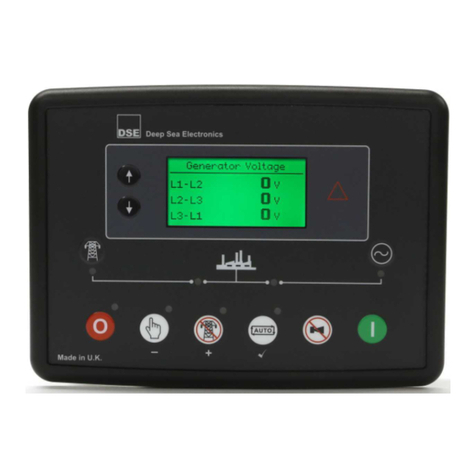
Deep Sea Electronics Plc
Deep Sea Electronics Plc DSE6120 MKII User manual
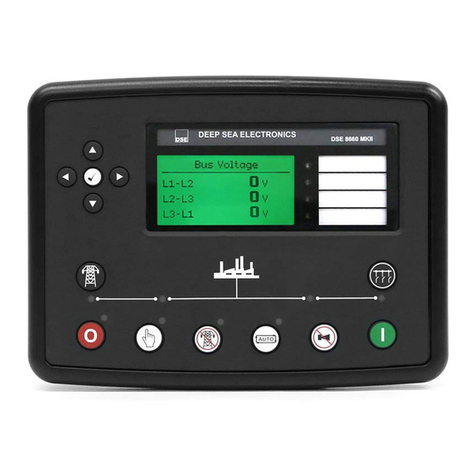
Deep Sea Electronics Plc
Deep Sea Electronics Plc DSE8660 MKII User manual
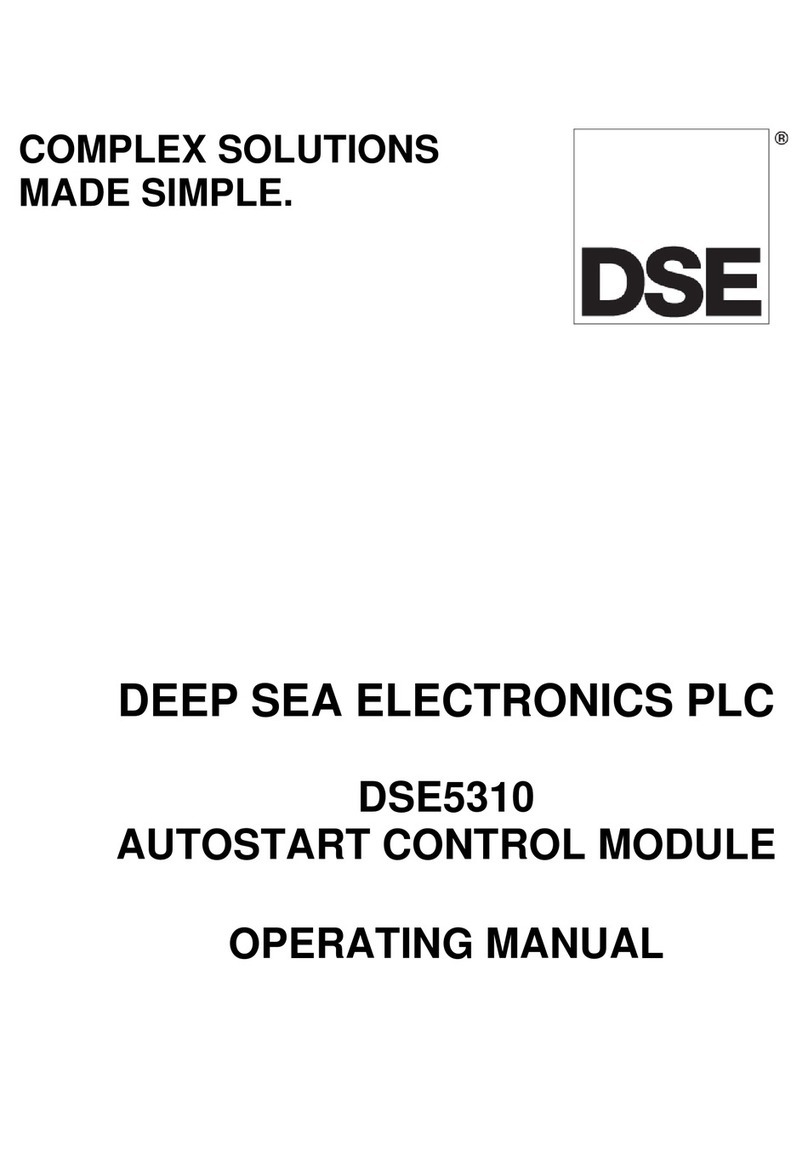
Deep Sea Electronics Plc
Deep Sea Electronics Plc DSE5310 User manual
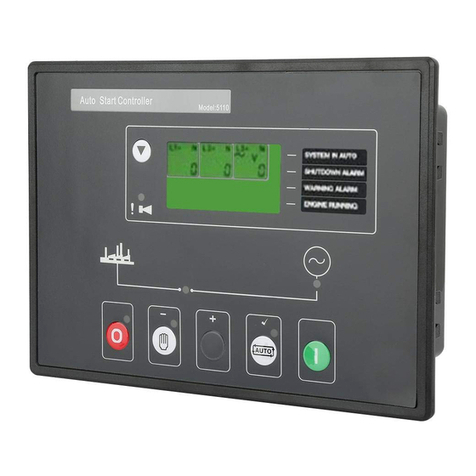
Deep Sea Electronics Plc
Deep Sea Electronics Plc DSE5110 User manual
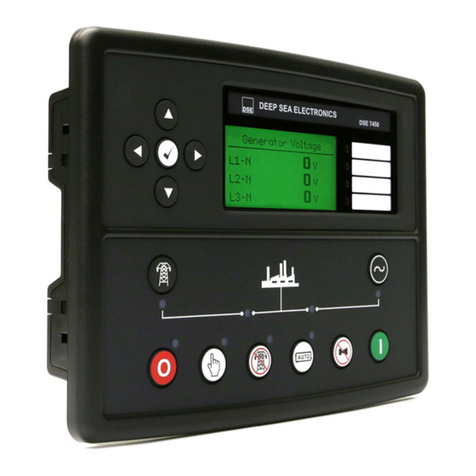
Deep Sea Electronics Plc
Deep Sea Electronics Plc DSE7450 User manual
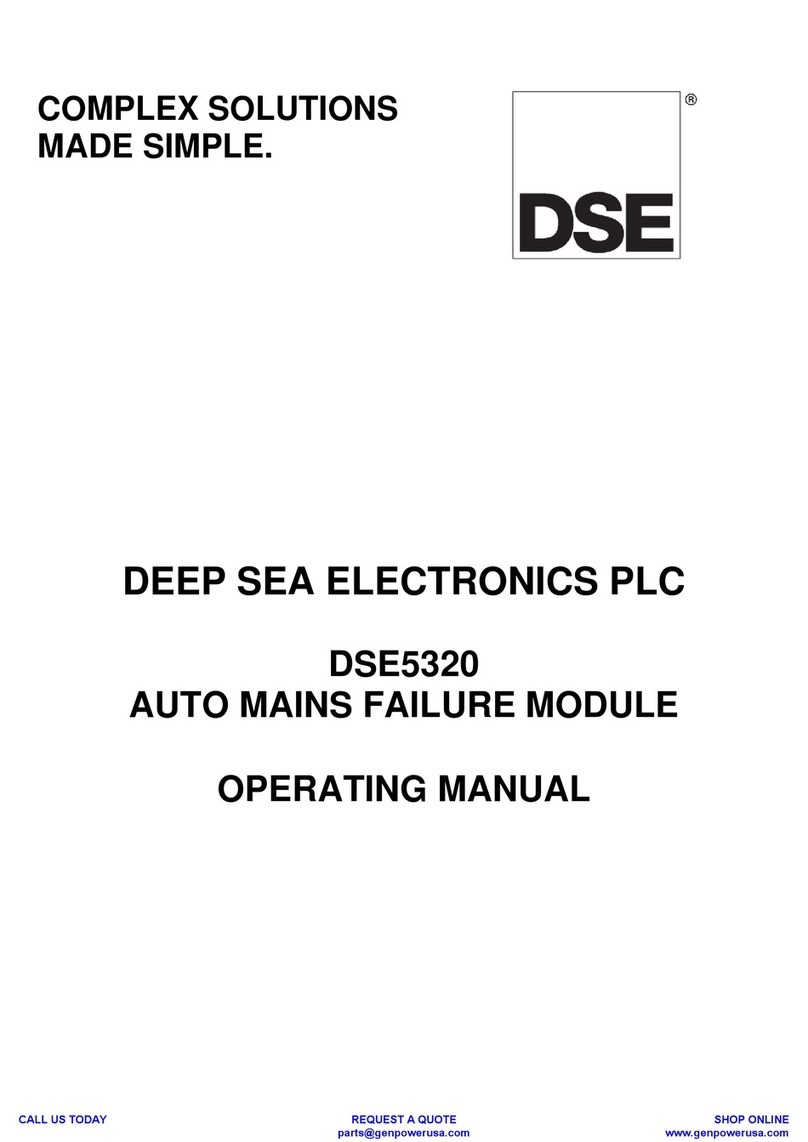
Deep Sea Electronics Plc
Deep Sea Electronics Plc DSE5320 User manual
